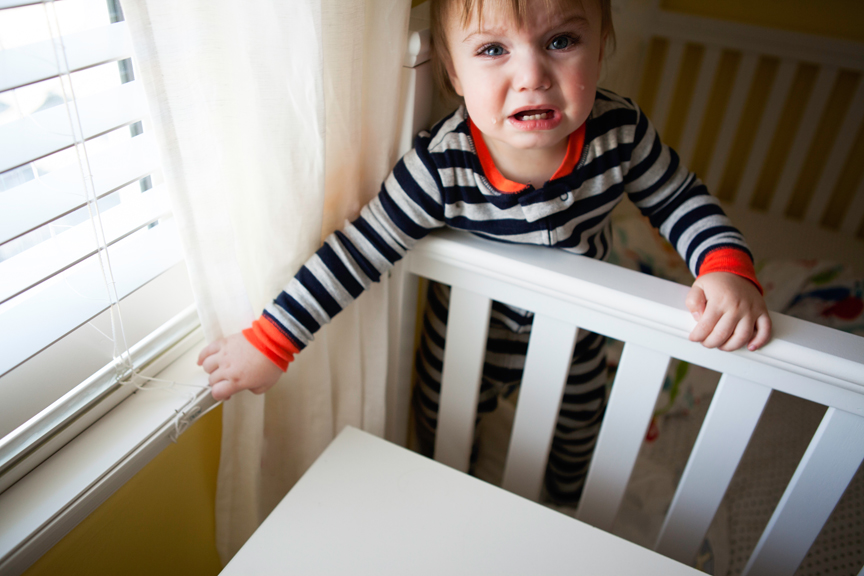- Behavior
- Parenting
- Safety
BLOG: Is it too early to discipline my toddler for not obeying me?

Question: My 1-year-old doesn’t listen to me or follow directions. She actually does the exact opposite of what I ask her to do. She even laughs and runs away when I try to discipline her. My husband thinks it’s funny, but I really get upset. Can a 1-year-old be put into time-out? Can I discipline her in some way? And am I hurting her emotionally if I do?
Answer: One-year-olds are excited they can now walk and talk! They get into a lot of things as they explore their newfound mobile independence. For parents, this may be a difficult transition – from the little baby they cuddled in their arms to the independent toddler running around them.
We didn’t need to discipline them when they were babies, so how do we do that now? Children grow within the context of their relationships and will test the boundaries of that relationship to see what is acceptable and what is not. Remember: This is normal, healthy behavior.
Set rules and structure
It’s the parents’ job to steer children in the right direction. They are fully dependent on us when born, from feeding and changing diapers to learning how to interact with the world. We, as adults, need to guide them on how to respond in socially and emotionally appropriate ways. By setting rules and structure, we assist in the child’s healthy development. At the Center for Child Counseling, we are taught it is an opportunity to teach, not punish, when a child makes a mistake or misbehaves.
Garry Landreth in his book, “Play Therapy: The Art of the Relationship,” (Brunner-Routledge, 2002, pp.259-262), gives three steps, called the ACT model, that we can follow to set limits, and give choices and natural consequences:
- Acknowledge the feeling.
- Communicate the limit.
- Target an acceptable alternative.
When acknowledging your children’s feelings, you connect what they may be feeling or thinking with their body’s reaction. This helps the child feel heard and understood and often stops the misbehavior. The limit is the rule set to ensure your safety, the child’s safety or the property’s safety. Lastly, you would show them the correct action to replace their inappropriate one.
To be effective, take these steps when the child is misbehaving and simply explain in a few words in a neutral tone. For example, your 1-year-old may be playing in the living room and throwing hard toys at the sliding glass door. To acknowledge the feeling, you can say, “You feel so excited when you play!” Then communicate the limit: “Hard toys are not for throwing.” The alternative can then be, “Roll them on the floor instead.”
Emphasize their choices
Your child may test the limits you just set. If this happens, Garry Landreth further explains the use of choices. You would follow the above ACT model when your child throws the hard toy again and say, “You can choose to play with these hard toys and roll them on the ground, or you can choose to throw the hard toys and choose for them to be put away. You choose.”
If the child rolls the toy on the ground, they have learned a skill that is socially appropriate. If they choose to continue throwing, you would follow through and put the hard toys away. If the child becomes upset, you can say, “You're very upset about your choice. Next time you can make a different choice.”
Through the use of choices, you teach your children to problem-solve and to take responsibility for their actions. We teach our children there is a natural consequence for the choices they make.
Follow-through is key
It can be frustrating when we feel our children are not listening. We sometimes need to step back and identify the reason behind their actions. What are they trying to communicate to us? Their language, although growing, is not fully developed.
Many children test their limits to see if the parent will follow through with what they proclaimed. Follow-through creates a sense of trust and safety for the child. Their environment becomes more predictable, and they are able to grow when they feel safe. So by you teaching your children their choices have weight, you are not hurting them emotionally, but helping them.
Hilary Jacques is director of the Child and Family Center in West Palm Beach for Center of Child Counseling in Palm Beach County.
You May Also Like
-
- Education
- Health
- Parenting
Hey! Why can't my child do that yet? (and should I worry?)
Children develop at their own pace. But it's natural to wonder whether your child is progressing at a typical rate versus possibly developing a learning disability. Free screenings …
Read More -
- Behavior
- Parenting
- Safety
Does your kid love putting things in his mouth? This is for you.
Almost 60 percent of non-fatal choking cases are food-related, while another 32 percent involve swallowing coins or gum. Check out these tips to prevent an accident or tragedy. …
Read More
Related resources
-
- Behavior
- Parenting
Center for Family Services of Palm Beach County
Positive Parenting Program, known as Triple P, offers free seminars and one-on-one guidance to help families improve the parent-child relationship
561-616-1222 Website Email -
- Behavior
- Health
- Parenting
Center for Child Counseling
Mental health services in Palm Beach Gardens for families, specializing in play therapy for children who've experienced trauma
1-800-480-1899 Website Email -
- Education
- Parenting
- Things to do
BRIDGES of Palm Beach County
Ten neighborhood hubs help parents raise children healthy, safe and strong
561-740-7017 Website -
- Behavior
- Parenting
Community Partners
Positive Parenting Program, known as Triple P — free seminars and one-on-one guidance to help families improve their parent-child relationships
561-841-3500 Website Email
